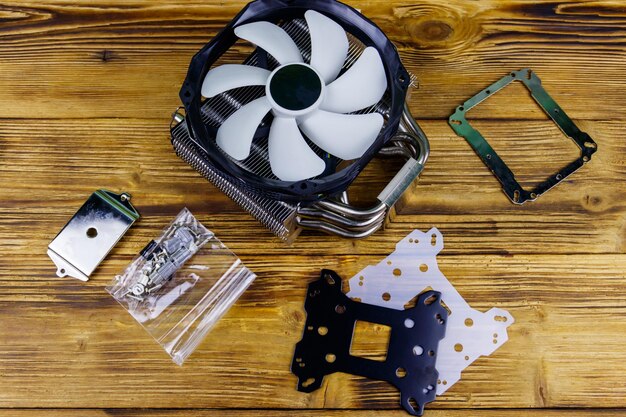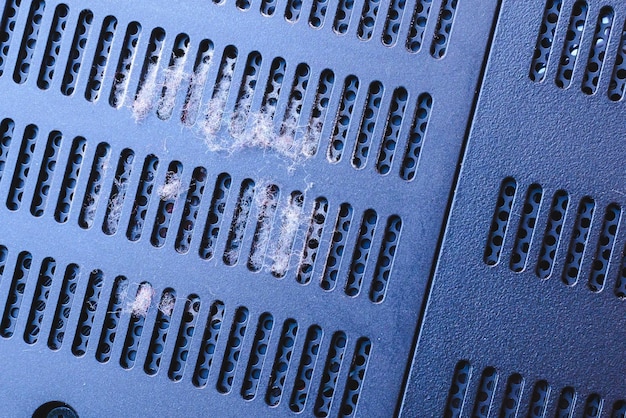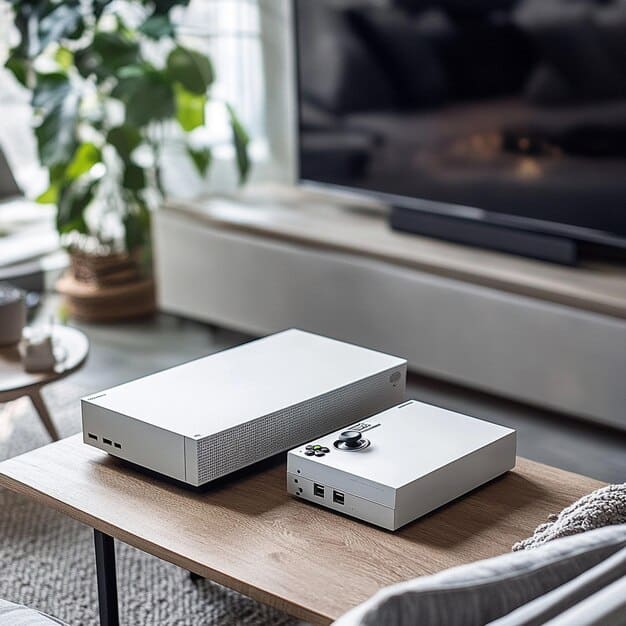Optimize Your Console’s Cooling: Prevent Overheating, Extend Lifespan

Optimize Your Console’s Cooling: Prevent Overheating and Extend Lifespan by 25% involves implementing strategies to manage console temperature, including cleaning vents, improving airflow, and using cooling accessories, to ensure optimal performance and longevity.
Is your console struggling with overheating, impacting your gaming experience? Discover how to optimize your console’s cooling: prevent overheating and extend lifespan by 25% by implementing simple yet effective strategies.
Understanding Console Overheating
Console overheating is a common issue many gamers face. It can lead to performance drops, system crashes, and even permanent damage if not addressed. Understanding the causes and signs of overheating is the first step in preventing it.
Several factors contribute to console overheating. Poor ventilation is a primary culprit, as consoles need adequate airflow to dissipate heat. Dust accumulation can also block vents and insulate internal components, trapping heat inside. Ambient temperature and prolonged use further exacerbate the problem.
Common Causes of Overheating
Identifying the root cause of overheating can help you tailor your approach to solving it.
- Dust Buildup: Dust accumulates inside the console, blocking airflow and insulating components.
- Poor Ventilation: Enclosed spaces limit airflow around the device, causing heat to build up rapidly.
- High Ambient Temperatures: Warm environments impact the console’s cooling efficiency.
- Prolonged Use: Extended gaming sessions generate significant heat inside the system.
Once you recognize potential cause the next step is to understand the systems warnings for overheating.
Signs Your Console is Overheating
Being alert for overheating signs will allows for a prompt action.
- Fan Noise: Increased fan speed and noise indicate the system is working harder to cool down.
- Performance Issues: Noticeable lag, stuttering, or freezing during gameplay.
- Sudden Shutdowns: The console turns off unexpectedly to prevent damage from excessive heat.
- Error Messages: Display alerts about overheating.
Understanding console overheating and its causes is essential for protecting your investment and enjoying uninterrupted gaming sessions. By addressing these issues proactively, you can significantly improve your console’s performance and longevity.

Regular Cleaning and Maintenance
Regular cleaning and maintenance are essential for preventing console overheating. Over time, dust and debris accumulate inside the console, blocking airflow and causing the system to work harder to stay cool. Simple cleaning routines can greatly improve your console’s thermal performance.
Gather necessary tools like a can of compressed air, microfiber cloths, and precision screwdrivers (if you plan to open the console for deeper cleaning). Then, power off and unplug your console before starting the cleaning process.
Cleaning Exterior Vents
The exterior vents are the first line of defense in maintaining optimal airflow.
Use compressed air to blow dust and debris out of the vents. Hold the can upright and use short bursts to avoid damaging the console’s internal components. Wipe the exterior surfaces with a microfiber cloth to remove any remaining dust.
Deep Cleaning the Interior (If Comfortable)
For more thorough cleaning, consider opening the console. However, be cautious and only proceed if you are comfortable with the process, as improper handling can damage the console.
Consult your console’s manual or online resources for instructions on safely disassembling it. Use compressed air to remove dust from internal components, such as the heat sink and fan. Ensure all components are dust-free before reassembling the console.
Regular cleaning and maintenance can help to optimize your console’s cooling: prevent overheating and extend lifespan by 25%. Integrating these practices into your routine will ensure your console runs cooler, quieter, and more efficiently, prolonging its life and maintaining optimal gaming performance.
Optimizing Console Placement and Ventilation
Proper console placement and ventilation play a crucial role in preventing overheating. Adequate airflow around the console allows heat to dissipate efficiently, keeping the system cool during intense gaming sessions. Optimizing placement and ventilation can significantly optimize your console’s cooling: prevent overheating and extend lifespan by 25%.
Ensure that the console is placed in an open area where air can circulate freely. Avoid placing it in enclosed spaces such as entertainment centers or cramped shelves, as these restrict airflow and trap heat. Ensure the console’s vents are not blocked by any objects.
Improving Airflow
Enhancing airflow around the console is an effective way to prevent overheating.
- Use a Stand: Elevate the console using a stand to provide better airflow underneath.
- Space from Walls: Position the console a few inches away from walls to allow air to circulate.
- Fan Placement: If the environment is naturally warm, consider placing a small fan nearby to blow cool air towards the console.
Ambient Temperature Considerations
High ambient temperatures can contribute to console overheating, making it essential to consider the room’s temperature where the console is placed.
- Avoid Direct Sunlight: Keep the console away from direct sunlight, as this can raise its temperature significantly.
- Cool Room: Ensure the room is adequately cooled, especially during prolonged gaming sessions.
- Air Conditioning: Use air conditioning or fans to maintain a cooler environment.
By considering these factors and implementing practical solutions, you can reduce the risk of overheating and ensure your device runs cooler and more efficiently.

Utilizing Cooling Accessories
Cooling accessories are designed to enhance airflow and dissipate heat more effectively. These accessories can be particularly beneficial for gamers who frequently engage in extended gaming sessions or live in warmer climates. Integrating cooling accessories into your setup further optimize your console’s cooling: prevent overheating and extend lifespan by 25%.
Cooling accessories come in various forms, each designed to address different aspects of console cooling. External fans, cooling stands, and internal modifications are among the popular options.
Types of Cooling Accessories
Understanding the variety of cooling accessories available will help you choose the best one for your needs.
External Fans: These fans attach to the console’s vents, drawing heat away from the system. They are easy to install and provide an immediate boost to cooling efficiency.
Cooling Stands: These stands elevate the console and incorporate built-in fans to improve airflow underneath. They offer a stable base and enhanced cooling simultaneously.
Internal Modifications: For advanced users, replacing the console’s thermal paste or adding a custom heat sink can provide significant cooling improvements. However, these modifications may void the warranty and require technical expertise.
Choosing the Right Accessories
Selecting the proper cooling accessories depends on the console and the level of cooling required.
Console Compatibility: Ensure the accessory is compatible with the console model.
Customer Reviews: Look for customer reviews and ratings to gauge the effectiveness of the accessory.
By selecting and installing the best cooling accessories, you can greatly reduce the risk of overheating and ensure your console performs optimally under various conditions.
Managing Gaming Habits
Even with the best cooling solutions, managing gaming habits is crucial for long-term console health. Prolonged gaming sessions can generate significant heat, stressing the console’s cooling system. Implementing sensible gaming habits will greatly optimize your console’s cooling: prevent overheating and extend lifespan by 25%.
Managing gaming habits involves setting limits on playtime, implementing breaks, and adjusting graphical settings to reduce strain on the console. These adjustments can help maintain lower temperatures.
Limiting Playtime
Setting limits on gaming sessions reduces the overall stress on the console’s cooling system.
- Time Limits: Set a time limit for gaming sessions to prevent continuous heat buildup.
- Regular Breaks: Take short breaks (15-20 minutes) every couple of hours to allow the console to cool down.
Adjusting Graphical Settings
Lowering graphical settings can reduce the load on the console’s processor and graphics card, generating less heat.
- Resolution Reduction: Lowering the resolution can significantly reduce the heat generated.
- Frame Rate Caps: Capping the frame rate can prevent the console from overworking to achieve unnecessary frame rates.
By implementing sensible gaming habits, you can significantly reduce the risk of overheating and maintain optimal performance. These adjustments can help ensure your console remains cool, reliable, and ready for countless hours of gaming.
Monitoring Console Temperature
Monitoring console temperature is a proactive way to ensure your system is operating within safe thermal limits. Keeping tabs on your console’s temperature will allow you to identify potential issues before they escalate, and further optimize your console’s cooling: prevent overheating and extend lifespan by 25%.
Knowing your console’s normal temperature range can help you recognize when it’s running too hot. Various tools and methods can be used to track these temperatures.
Using Built-In Monitoring Tools
Some consoles have built-in monitoring tools that provide insights into the system’s temperature.
System Settings: Check your console’s settings menu for temperature monitoring options.
While built in system tools are good, they aren’t always available.
Alternative Monitoring Methods
If your console doesn’t have built-in tools, external methods can be used to monitor temperature.
- Infrared Thermometers: Use an infrared thermometer to measure the surface temperature of the console.
- Software Overlays: On PCs, use software overlays to track CPU and GPU temperatures during gaming.
Keep a log of temperature readings to spot trends and patterns. Sudden spikes or consistently high temperatures may indicate a problem with cooling, prompting further investigation.
| Key Point | Brief Description |
|---|---|
| 🎮 Regular Cleaning | Clean vents to prevent dust buildup and improve airflow. |
| ⬆️ Optimize Placement | Ensure the console has adequate ventilation and is not enclosed. |
| ❄️ Cooling Accessories | Utilize external fans or cooling stands for better heat dissipation. |
| ⏱️ Manage Gaming | Limit playtime and adjust graphics settings to reduce heat. |
[FAQ]
▼
Optimizing console cooling prevents overheating, which can cause performance issues, crashes, and permanent damage. Proper cooling ensures your console runs smoothly and lasts longer.
▼
Clean your console every 3-6 months to prevent dust buildup. If you live in a dusty environment or use your console frequently, consider cleaning it more often.
▼
Signs include increased fan noise, performance lag, sudden shutdowns, and error messages related to overheating. Check the console’s temperature if possible using built in apps on some systems.
▼
Yes, cooling accessories like external fans and cooling stands can significantly improve heat dissipation, especially for extended gaming sessions or in warm environments. Choose accessories compatible with your console model.
▼
Yes, lowering the resolution or capping the framerate can reduce the load on the console’s processor and graphics card generating less heat. Try lowering your resolution for better performance.
Conclusion
By following these strategies you can optimize your console’s cooling: prevent overheating and extend lifespan by 25%, maintain a temperature adequate to the device, and maintain optimal performance. Regular cleaning, optimizing placement, utilizing cooling accessories, managing gaming habits, and monitoring temperature are key to ensuring your device has a long lasting life.





